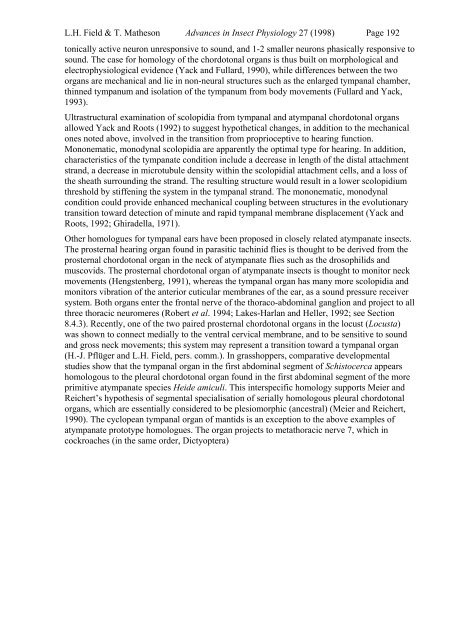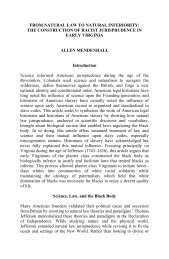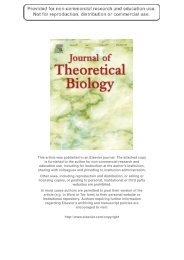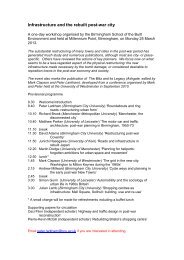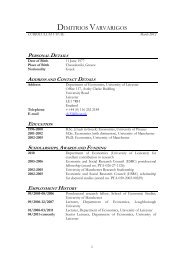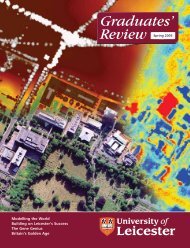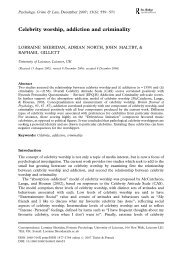Chordotonal Organs of Insects
Chordotonal Organs of Insects
Chordotonal Organs of Insects
You also want an ePaper? Increase the reach of your titles
YUMPU automatically turns print PDFs into web optimized ePapers that Google loves.
L.H. Field & T. Matheson Advances in Insect Physiology 27 (1998) Page 192tonically active neuron unresponsive to sound, and 1-2 smaller neurons phasically responsive tosound. The case for homology <strong>of</strong> the chordotonal organs is thus built on morphological andelectrophysiological evidence (Yack and Fullard, 1990), while differences between the twoorgans are mechanical and lie in non-neural structures such as the enlarged tympanal chamber,thinned tympanum and isolation <strong>of</strong> the tympanum from body movements (Fullard and Yack,1993).Ultrastructural examination <strong>of</strong> scolopidia from tympanal and atympanal chordotonal organsallowed Yack and Roots (1992) to suggest hypothetical changes, in addition to the mechanicalones noted above, involved in the transition from proprioceptive to hearing function.Mononematic, monodynal scolopidia are apparently the optimal type for hearing. In addition,characteristics <strong>of</strong> the tympanate condition include a decrease in length <strong>of</strong> the distal attachmentstrand, a decrease in microtubule density within the scolopidial attachment cells, and a loss <strong>of</strong>the sheath surrounding the strand. The resulting structure would result in a lower scolopidiumthreshold by stiffening the system in the tympanal strand. The mononematic, monodynalcondition could provide enhanced mechanical coupling between structures in the evolutionarytransition toward detection <strong>of</strong> minute and rapid tympanal membrane displacement (Yack andRoots, 1992; Ghiradella, 1971).Other homologues for tympanal ears have been proposed in closely related atympanate insects.The prosternal hearing organ found in parasitic tachinid flies is thought to be derived from theprosternal chordotonal organ in the neck <strong>of</strong> atympanate flies such as the drosophilids andmuscovids. The prosternal chordotonal organ <strong>of</strong> atympanate insects is thought to monitor neckmovements (Hengstenberg, 1991), whereas the tympanal organ has many more scolopidia andmonitors vibration <strong>of</strong> the anterior cuticular membranes <strong>of</strong> the ear, as a sound pressure receiversystem. Both organs enter the frontal nerve <strong>of</strong> the thoraco-abdominal ganglion and project to allthree thoracic neuromeres (Robert et al. 1994; Lakes-Harlan and Heller, 1992; see Section8.4.3). Recently, one <strong>of</strong> the two paired prosternal chordotonal organs in the locust (Locusta)was shown to connect medially to the ventral cervical membrane, and to be sensitive to soundand gross neck movements; this system may represent a transition toward a tympanal organ(H.-J. Pflüger and L.H. Field, pers. comm.). In grasshoppers, comparative developmentalstudies show that the tympanal organ in the first abdominal segment <strong>of</strong> Schistocerca appearshomologous to the pleural chordotonal organ found in the first abdominal segment <strong>of</strong> the moreprimitive atympanate species Heide amiculi. This interspecific homology supports Meier andReichert’s hypothesis <strong>of</strong> segmental specialisation <strong>of</strong> serially homologous pleural chordotonalorgans, which are essentially considered to be plesiomorphic (ancestral) (Meier and Reichert,1990). The cyclopean tympanal organ <strong>of</strong> mantids is an exception to the above examples <strong>of</strong>atympanate prototype homologues. The organ projects to metathoracic nerve 7, which incockroaches (in the same order, Dictyoptera)


